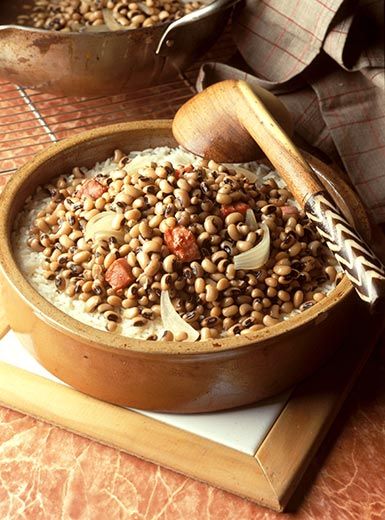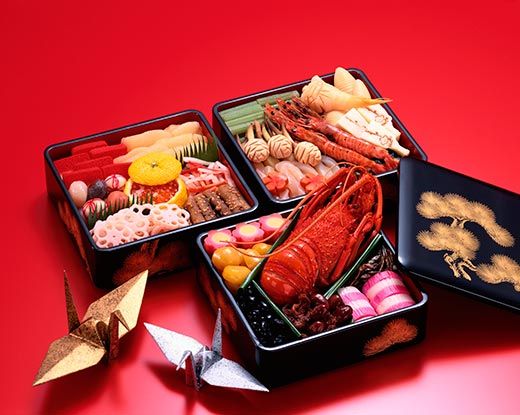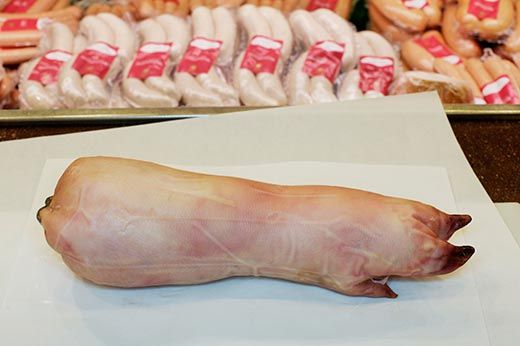Lucky Foods for the New Year
Pigs, fish, beans and cakes are among the many delicacies consumed around the world to celebrate the new year
/https://tf-cmsv2-smithsonianmag-media.s3.amazonaws.com/filer/New-Years-food-jubakos-631.jpg)
My Italian grandfather was known to eat a lot of strange things: pickled eels, tripe and anything slimy that would be considered disgusting to most children. For New Year’s Day his favorite food was a giant gelatinous sausage called cotechino, cut into sections and smeared with mustard. My brother and I joked that the sausage must have been made from the worst of the pig, like the eyes.
As an adult, I developed a taste for cotechino (which contains plenty of pig fat, but no eyeballs), and have learned that this delicacy, and pork in general, is often considered a propitious food to eat at the beginning of the year. Many of our holiday customs go back to when we were an agrarian society. “In many parts of Europe, pigs were easier to grow than cows because they take up less space and eat anything,” says Janet Chrzan, a nutritional anthropologist at the University of Pennsylvania. “And pigs were slaughtered around the time of the winter solstice.”
Food has always been a powerful symbol, especially during rites of passage, such as the start of a new year. “It’s hard to know which came first – the belief in the food being lucky, or the tradition of eating it because it was available, and then attaching meaning to it,” says food historian and author Andrew F. Smith.
What one eats often depends on his or her family heritage. Here are some of the world’s popular culinary traditions for an auspicious new year.
Fat of the Land: Pork has always been a symbol of the “fat of the land,” says Betty Fussell, author and food historian. “If a family had a pig to slaughter, they felt prosperous and were assured of food in the coming winter months.” Even our Congressional slang “pork barrel” echoes a time when Americans stored salted pork in wooden barrels and the amount of meat indicated the state of the family’s circumstances. In folklore the pig is considered an animal of progress because it moves forward while rooting around for food. Chickens and turkeys scratch backward and are believed by some people to represent setbacks and struggle in the coming year, making them an unpopular choice for a New Year’s Day dinner. A suckling pig is the main gastronomic attraction for New Year festivities in Spain, Portugal, Cuba and Hungary. Roasted whole, the young pigs, just 2 to 6 weeks old and still on mother’s milk, are tender and succulent. Austrians decorate their New Year’s dinner table with miniature marzipan pigs and give them to friends as good luck charms. Germans eat a variety of pork-based sausages at this time of year, including bratwurst and weisswurst. Cotechino, my grandfather’s favorite, remains popular in Italy, along with zampone, a deboned pig trotter (the foot and ankle) stuffed with sausage meat. American Southerners favor ham and ham hocks (sections of the pig’s hind leg), while farther north in Pennsylvania and the Midwest, revelers tuck into pork ribs and kielbasa sausage with sauerkraut and potatoes.
Go Forth and Multiply: Abundance and plenty are typical wishes for the New Year, and seafood is often the symbolic fare. “Fish have always been a loaded fertility symbol because they produce multiple eggs at one time,” say Fussell, In Japan, stores sell decorated jubakos, small stackable food boxes filled with well-wishing food for the New Year: prawns for long life, herring roe for fertility and sardines, which in the past were used as fertilizer for rice crops. Consuming pickled herring at the stroke of midnight on New Year’s Eve in Germany, Poland and parts of Scandinavia is associated with a bountiful catch. Swedes enjoy a smorgasbord of seafood dishes including shrimp, salmon, crab, oysters and anchovies. In Denmark, boiled cod is the seafood of choice. In Chinese, the word for fish is a homonym that sounds like the word for “abundance.” Fish are served whole, head and tail intact, symbolizing a good beginning and end in the coming year. The one seafood that some cultures avoid eating is lobster, because it swims backward!
Bean Counters: A compartment in the Japanese jubako box is reserved for black beans, which are eaten to ensure health. But most legumes eaten at the beginning of the year represent coins or monetary units, says Fussell. Lentils accompany many of the popular European sausages. Along with the ham hocks or ham on New Year’s Day U.S. Southerners often eat Hoppin’ John, a dish of black-eyed peas and rice. The dish originated with slaves from West Africa, but the name is still a mystery. Usually Hoppin’ John is served with collards, kale or chard, with the leafy greens representing paper currency and prosperity in the new year. The Danish add a little sweetness to their monetary wishes in a recipe of stewed kale with cinnamon and sugar. And in Croatia and Slovakia, minced meat is wrapped in cabbage leaves for the New Year’s Eve feast.
Long Life: Soba noodles signify a long life and in Japan, they are often eaten at Buddhist temples at midnight on New Year’s Eve. Recently some Japanese have started including noodles in the New Year’s jubako boxes, though noodles were not part of the boxed food tradition. The Chinese also eat long noodles, and typically, Asian cultures believe that cutting them shorten one’s life.
Let Them Eat Cake: Baking cakes and breads with a coin or trinket inside is a common practice in many countries. Whoever gets the slice with the prize is predicted to have a particularly wonderful year. In Greek tradition, the cake or bread called Vasilopita is named for St. Basil, whose is commemorated on January 1. St. Basil, a fourth-century advocate for the poor, performed one of many miracles—returning lost jewels to their rightful owners inside cakes. In parts of Scandinavia, a similar holiday tradition involves hiding an almond in rice pudding to bring good fortune to the lucky eater. A sweet sticky rice cake called nian gao, which means “year cake,” is a popular treat at Chinese New Year celebrations. Scotland has a “first-footer” tradition—the first person in one’s home sets the tone for the year to come and is expected to bring shortbread or black bun (a dark fruitcake) and whiskey. Back in the day, the first-footer also brought coal for warmth. In return, the visitor would be rewarded with food and drink.
In most cultures today, the drink of choice is champagne. The sparkling wine from France went from being the luxury beverage served at a king’s coronation to toasting in the new year. For those who drink too much this eve, Betty Fussell recommends a traditional Mexican hangover soup called posole, made with hominy, chilies and a prosperous bit of pork shoulder.



